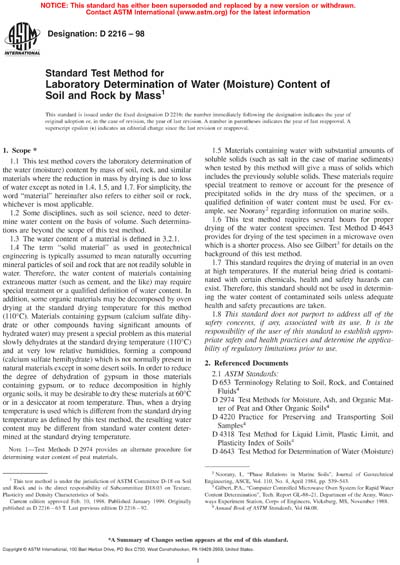Historical
ASTM D2216-98
Standard Test Method for Laboratory Determination of Water (Moisture) Content of Soil and Rock by Mass
This test method covers the laboratory determination of the water (moisture) content by mass of soil, rock, and similar materials where the reduction in mass by drying is due to loss of water except as noted in 1.4, 1.5, and 1.7. For simplicity, the word "material" hereinafter also refers to either soil or rock, whichever is most applicable. 1.2 Some disciplines, such as soil science, need to determine water content on the basis of volume. Such determinations are beyond the scope of this test method. 1.3 The water content of a material is defined in 3.2.1. 1.4 The term "solid material" as used in geotechnical engineering is typically assumed to mean naturally occurring mineral particles of soil and rock that are not readily soluble in water. Therefore, the water content of materials containing extraneous matter (such as cement, and the like) may require special treatment or a qualified definition of water content. In addition, some organic materials may be decomposed by oven drying at the standard drying temperature for this method (110°C). Materials containing gypsum (calcium sulfate dihydrate or other compounds having significant amounts of hydrated water) may present a special problem as this material slowly dehydrates at the standard drying temperature (110°C) and at very low relative humidities, forming a compound (calcium sulfate hemihydrate) which is not normally present in natural materials except in some desert soils. In order to reduce the degree of dehydration of gypsum in those materials containing gypsum, or to reduce decomposition in highly organic soils, it may be desirable to dry these materials at 60°C or in a desiccator at room temperature. Thus, when a drying temperature is used which is different from the standard drying temperature as defined by this test method, the resulting water content may be different from standard water content determined at the standard drying temperature. Note 1-Test Methods D2974 provides an alternate procedure for determining water content of peat materials. 1.5 Materials containing water with substantial amounts of soluble solids (such as salt in the case of marine sediments) when tested by this method will give a mass of solids which includes the previously soluble solids. These materials require special treatment to remove or account for the presence of precipitated solids in the dry mass of the specimen, or a qualified definition of water content must be used. 1.6 This test method requires several hours for proper drying of the water content specimen. Test Method D4643 provides for drying of the test specimen in a microwave oven which is a shorter process. 1.7 This standard requires the drying of material in an oven at high temperatures. If the material being dried is contaminated with certain chemicals, health and safety hazards can exist. Therefore, this standard should not be used in determining the water content of contaminated soils unless adequate health and safety precautions are taken. 1.8 This standard does not purport to address all of the safety problems, if any, associated with its use. It is the responsibility of the user of this standard to establish appropriate safety and health practices and determine the applicability of regulatory limitations prior to use.###
ASTM International [astm]

